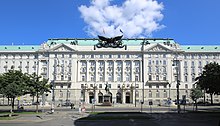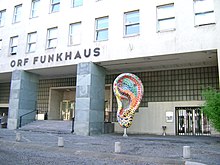ORF (broadcaster)
This article includes a improve this article by introducing more precise citations. (March 2023) ) |
Television and radio network | |
| Country | Austria |
|---|---|
| Availability | Austria; parts of Czech Republic, Germany, Hungary, Italy, Liechtenstein, Slovakia, Slovenia and Switzerland |
| Headquarters | ORF-Zentrum, Hugo-Portisch-Gasse 1, 1136 Wien, Vienna |
Key people | Roland Weißmann (Director General) |
Launch date | 1 August 1955 |
Former names | Ravag (Radio Verkehrs AG) |
Official website | www der |
Österreichischer Rundfunk (lit.: 'Austrian Broadcasting'; ORF, German:
History of broadcasting in Austria

The first unregulated test transmissions in Austria began on 1 April 1923 by
Radio Verkehrs AG
It was, however, the public Radio-Verkehrs-Aktiengesellschaft ('Radio Communication Company Ltd', RAVAG), a joint venture of the
Radio programmes aimed at an educated audience, featuring classical music, literature, and lectures. The first

In the course of the abolition of the
Reichssender Wien
With the Austrian Anschluss to Nazi Germany and the invasion of Wehrmacht troops in 1938, RAVAG was dissolved and replaced by Reichssender Wien subordinate to the national Reichs-Rundfunk-Gesellschaft network (Großdeutscher Rundfunk from 1939) in Berlin, where programmes were also produced from. One of the last RAVAG transmissions was Schuschnigg's farewell address on 11 March 1938 ('God Save Austria'). Only hours later, live broadcasts featured the cheering devotees of his Nazi successor Arthur Seyss-Inquart (1892–1946), the triumphant entry of Adolf Hitler in Linz the next day, and his speech on Heldenplatz in Vienna. In 1939, the former RAVAG transmission facilities were taken over by the German Reichspost.
In
Radio Wien
Following the Wehrmacht defeat, independent Austrian RAVAG radio broadcasting resumed in Allied-occupied Austria 24 April 1945, when it announced the formation of a provisional Austrian state government led by Karl Renner (1870–1950). A new Radio Wien station was founded, broadcasting from Funkhaus Wien by a provisional transmitter on the rooftop, once again under Oskar Czeija, who nevertheless was ousted shortly afterward on pressure by the Soviet military administration. As the Funkhaus was located in the Soviet occupation sector of Vienna, the Western Allies established their own radio stations like the Alpenland network on British-occupied territory, Radio Rot-Weiß-Rot on US-occupied territory, Sendegruppe West on French-occupied territory, as well as the American English-speaking 'Blue Danube' armed forces network (BDN; not to be confused with the later Blue Danube Radio) and the British Forces Network (BND), which became quite popular with younger Austrian listeners. The RAVAG/Radio Wien transmissions were limited to the Eastern Austrian Soviet occupation zone, and as the Cold War progressed was increasingly considered Communist propaganda broadcasting.
Several other radio stations began broadcasting in the different occupation zones and radio became a popular medium among Austrians: in 1952 there were 1.5 million radio sets in Austrian homes. The Western Allies could operate their programmes nationwide from Vienna, with a significantly higher popularity rating than the outdated RAVAG transmissions. In 1955, the various regional stations were brought together as the Österreichisches Rundspruchwesen ('Austrian Broadcasting Entity') which later, in 1958, became the Österreichischer Rundfunk GmbH, forerunner of today's ORF.
Radio channels
- Ö1 – ORF's cultural and principal news channel
- Hitradio Ö3 – pop music channel
- FM4 – channel for (alternative) youth culture
The former
All of these radio channels are broadcast terrestrially on FM and via the digital service of the SES Astra satellites at 19.2° east.
All of ORF's domestic radio channels are also streamed over the internet. An extra 24-hour all-news channel is available exclusively via internet: this is Ö1 Inforadio which relays all of Ö1's news content and fills the 'gaps', during which Ö1 is transmitting music and cultural programmes, with additional news broadcasts.
A version of Ö1 is broadcast internationally via
An additional service, Radio 1476, formerly broadcast on medium wave each evening from 18.00 until just after midnight. Its schedule was a mixture of items from Ö1, programmes for linguistic and cultural minorities, folk music, and special productions.
Television channels
- ORF 1
- ORF 2 (with regional programmes)
- ORF 2 Europe
- ORF III
- ORF Sport +
- 3sat (in association with ARD, ZDF and SRF)
The ORF television channels are broadcast
ORF is a supporter of the Hybrid Broadcast Broadband TV (HbbTV) initiative that is promoting and establishing an open European standard for hybrid set-top boxes for the reception of broadcast TV and broadband multimedia applications with a single user interface. From 6 March 1995 ORF broadcasts 24 hours a day.
Regional studios
The ORF has one regional studio in each state, where each state produces its own radio and state television, which is broadcast over ORF2. The regional studio in
Funding
The ORF is funded by a
| State | Television | Radio |
|---|---|---|
| Burgenland | €341.40 | €94.92 |
Carinthia
|
€330.60 | €92.52 |
| Lower Austria | €339.00 | €93.72 |
| Upper Austria | €269.40 | €75.72 |
| Salzburg | €325.80 | €94.92 |
| Styria | €343.80 | €94.92 |
| Tyrol | €317.40 | €88.92 |
| Vorarlberg | €269.40 | €75.72 |
| Vienna | €339.00 | €94.20 |
From January 2024, as part of reforms to the ORF tabled by the Nehammer Cabinet, the GIS organisation will be abolished and its associated TV licensing fee is expected to be replaced with a new compulsory ORF household tax, administered by ORF-Beitrags Service GmbH. As a result, some loopholes such as removing the antenna or tuner from television sets in order to declare them "GIS-Free" and hence exempt from the GIS fee (declared legal in a report to the Austrian Parliament in 2008,[2] and confirmed as such by the Supreme Administrative Court of Austria in 2015,[3] hence creating a market for selling regular and smart TVs without built-in antennas or tuners[4]) will be closed under the new system.[5]
Major stars
Many of Austria's best known TV stars work for ORF. According to surveys the most prominent television presenter in the country is former alpine skier
Logos
The ORF's first
See also
References
- ^ "Übersicht". GIS (in German). Retrieved 24 February 2018.
- ^ https://www.parlament.gv.at/dokument/XXIV/III/63/imfname_159777.pdf
- ^ https://web.archive.org/web/20150723110038/https://www.vwgh.gv.at/medien/ro_2015150015.pdf?4zdiv7
- ^ "Warum die GIS-freien TVS jetzt noch besser werden". 13 September 2021.
- ^ "Haushaltsabgabe: Alle Infos über den ORF-Beitrag, der ab 2024 die GIS-Gebühr ersetzt!". 12 July 2023.
External links
- Official website (in German)
- Official corporate website (in German)
- ORF on Instagram
- ORF on Facebook


